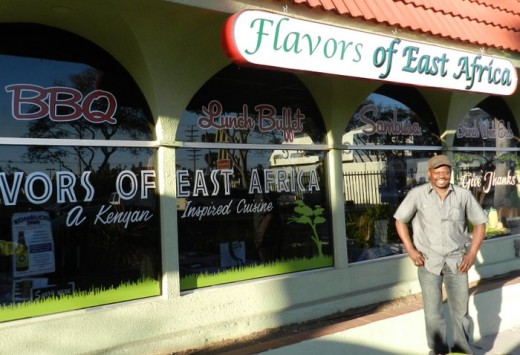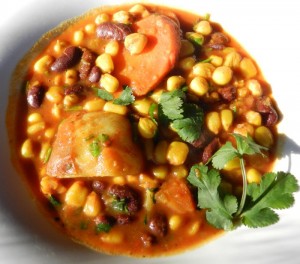 June Owina, in front of his restaurant, Flavors of East Africa.
June Owina, in front of his restaurant, Flavors of East Africa.
The following article appeared on the new KPBS blog, Hey Neighbor! Written by KPBS Director of Diversity and Engagement Monica Medina, Hey Neighbor! explores the people and places that make San Diego an extraordinary place to live.
In Swahili there is no specific word for kale or collard greens. They are rather poetically known as “sukuma wiki,” which means “push the week” or “stretch the week.” This is because kale and collard greens, which are staples of the East African diet, are grown fairly easily and are commonly eaten for lunch and dinner. So, they provide an easy way to fill out the menu and, before you know it, a week of meals is gone. Pushed. Sukuma wiki.
This is just one of the fascinating tidbits I learned from June Owina, owner of Flavors of East Africa restaurant, located in the bustling area of University Heights on El Cajon Boulevard. Owina, who hails from Kenya, is a gregarious man who loves telling stories and making people laugh. He arrived in San Diego in 2001, with the idea that he would find work as an accountant, which is his area of expertise. But when the downturn in the economy came and he found himself without a job, he began to look around to figure out what else he could do.
“One day a friend came over to my place and saw me cooking,” Owina remembers. “He was impressed with the meal I prepared. So, he told me, ‘Tomorrow I’m going to go to the Vons and buy the food so you can cook for me.’ I was jobless, so I began cooking. He’d buy the food. Soon I started cooking at the farmer’s market, and I said, I know how to do this.”
It wasn’t long before Owina decided to open his own restaurant, where one of his favorite recipes to prepare is nyoyo (see recipe below), another Kenyan staple that is made with hominy, beans and, often, potatoes, too.
“This kind of dish you can eat anytime of the year,” Owina says. “The only time my people use fresh corn is when they’re harvesting. Once the corn has been harvested, dried up and put in the storage, and the beans too, you can store it and have a whole stock of food for an entire year. As long as you keep it dry and away from the weevils, you can have food that is sustainable and very easy to cook. Just boil the corn and the beans. You don’t have to fry or sauté. Just add salt and eat it like that. It’s very affordable.”
According to Owina, there are over 40 tribes in Kenya, and nyoyo is a mainstay of the Kikuyu tribe. “I’m not from Kikuyu, but I am from Lake Victoria, the Luo tribe.
Because of our proximity to the lake, we eat fish.”
Owina, who lived with 24 brothers and sisters, and his six mothers, learned the basics of food preparation from his grandmother, including how to chop vegetables, efficiently and quickly. He has applied these lessons to the work he does today.
“I just did the basics of what I knew. You cannot mix this spice with that spice. I learned by experimenting, too. Creativity comes in. Today, I can cook for 10 people in one hour. I can chop faster. Before I go in the kitchen, I already know what I’m going to be doing. I never look at recipes, only the picture.”
Kenyan food draws from several influences. “Kenya is by the coast,” explains Owina. “There’s British influence, India influence. The Arabs coming across the sea and there’s that influence. They used to come as merchants and trade. They brought spices, which then mingled with the native influence.”
Cilantro is one of Owina’s favorite ingredients, but he also relies on a variety of spices. “I use a lot of cumin, curry, turmeric. A little bit of dill, parsley, oregano, cloves, and ginger, here and there, but mostly with tea. For me, cooking is about heat and timing. We can have the same ingredients, but using a low flame is going to taste different than when cooking with a high flame. And restaurant food tastes different from food made at home. Restaurant food is cooked with intense heat in a very short amount of time. It’s the heat that gives food a different flavor.”
Before coming to San Diego, Owina lived briefly in Texas, but the humidity proved too much for him, and so he ended up here, where he enjoys sharing the dishes of East Africa. He is happy to call San Diego home.
“I had to call my mum (in Kenya) and tell her that this place, San Diego, it rained twice in a year. Twice! When I lived in India, we’d have monsoon season for three months. It’s nonstop and we were always wet! But, really, I don’t do so well with high heat or cold. I’ve never even seen snow in my life, except in an ice machine.”
 |
Flavors of East Africa recipe for Nyoyo:
Serves 6
3 cups Mexican-style hominy (boil if dry)
2 cups red kidney beans (boil if dry)
3 large carrots, peeled
4 red potatoes, cut in quarters
1 medium-sized onion, diced
4 large Tomatoes, diced
4 cloves of Garlic, diced
1 bell pepper, diced
1 bunch cilantro, chopped
3 oz., olive oil
1 tablespoon, curry
½ teaspoon, turmeric
½ teaspoon, cumin
½ teaspoon, salt
Heat olive oil to a boil. Add diced garlic, diced onions, turmeric and curry.
Add tomato and stir. Add potato and carrots. Stir. Add one cup of water. Cover for about five minutes or until potato is half cooked. Then add hominy, kidney beans and bell pepper.
Let boil for an additional five minutes. Add cilantro, salt to taste and serve.
